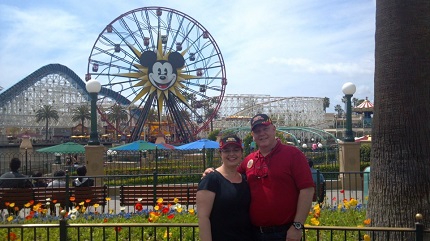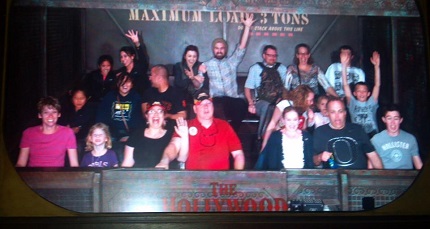
| Print | Back |  |
July 4, 2014 |
 |
Pebbles, Potholes, and Perspective Lessons Learned from Disney's California Adventureby Sarah Hancock |
In 2013, I realized I hadn’t been to anything Disney in 20 years. For a southern California girl, that’s a long time.
My sweetie and I saved our pennies. When the exciting day arrived, we drove up after work, stayed the night in a poor excuse for a hotel, woke up early the next morning and arrived well refreshed and ready to for our adventure.
I felt like a kid all over again, tingling with joy and ready to have at all the excitement, practically skipping through the streets with a big, cheesy grin on my face.
You can learn a lot about how to treat people with mental illness from Disney’s California Adventure. (For those of you who do not know, Disney’s California Adventure is a second Disney theme park, built adjacent to the original Disneyland in — you guessed it — Anaheim, California.)

As we arrived, a cast member asked us if we’d ever been to California Adventure. Nope. Guess what? They gave us a special sticker as an award for trying something new and to help everyone around us know that we were new to this.
Additionally, when they found out we came to celebrate my birthday, I got a happy birthday sticker.
Everyone and their cousin wished me a happy birthday. People I didn’t even know came up to tell me happy birthday and that they were happy I had come.
What would it be like if more of us followed the sticker cues? Would we take time to notice those around us who maybe feel awkward or lost? Would we offer a friendly “hello,” or start a cheerful conversation? Would we take a moment to look for the good and openly compliment people on their achievements, no matter how big or small?
I mean it was my birthday, but really, I just woke up and got out of bed just like anyone else at the park that day. What would it take for all of us to just walk up to someone, even if we didn’t know them, introduce ourselves and wish them a happy day?
I’m the kind of girl that likes roller coasters — the bigger, the better — just thrilled to go on as many as I could, as quick as I could. My sweetie doesn’t march to the same beat. From here on out, I’ll refer to him as The Nauseous One.

After three rides (one of which was the slow moving Ferris wheel), he was about ready to pass out. We found him a shaded bench, tucked away in a relatively quiet corner, to rest his stomach.
Nearby, sweeping up the trash from under the tables, a young man took notice. After about 10 minutes of The Nauseous One lying motionless on the bench, this Cast Member (standard name given to all employees) came up to us and asked how things were.
When I explained that my husband was nauseated and asked if there was a first-aid stand near, the Cast Member apologized and explained that he could radio a cart to come pick us up. The idea of riding in a cart did not bode well with The Nauseous One. He flat-out refused to leave the bench.
The Cast Member smiled. He thought for a moment. Suddenly his smile got brighter. “Well, would you like some soda to calm your stomach?”
Although the idea was appealing, we had no money for amusement-priced soda. Again the Cast Member smiled, instructed us not to worry and walked away. Five minutes later, he returned with a free soda and handed it to The Nauseous One, explaining that it was on the house.
What would it be like if we all followed this Cast Member’s lead, paid attention to our surroundings, recognized when someone didn’t look like they were feeling well and offered to help? When living with acute symptoms, I would have given anything for someone to willingly approach me, ask me how I was doing, actively listen to my answer and offer support.
Sometimes people don’t want the help we want to give. However, maybe if we offer something else or ask them how they would like us to help, a solution can be found.
For example, some people with mental illness aren’t yet willing to take medications. There are as many reasons not to take medications as there are people. However, medication is just one tool in treating mental illness.
Taking a walk, using ear plugs, listening to music, getting out of the house with a friend, prayer, taking a shower, meditation, reading scriptures, attending church, talking with a trusted friend or countless other tools can also help. The important thing is to help people in the way they feel most comfortable.
Just as the Cast Member didn’t force The Nauseous One to get on a cart bound for the first-aid station, he helped find a solution with which The Nauseous One was comfortable. In fact, he brainstormed one which, although not convenient for the Cast Member, was agreeable to The Nauseous One.
After the Cast Member handed off the soda, he walked away. Imagine my surprise when he came back 15 minutes later to see how The Nauseous One was doing. By that time, the Cast Member probably should have been off sweeping another area or even on break, but he still came back to verify that The Nauseous One was improving.
How many times have I served someone, met the need and walked away, thinking my job was done, eager to get back to what I was doing? If I had been left up to my own devices, I might have just ditched The Nauseous One, gone on a ride and come back after my needs were met.
I paid my good money to get into that park. I was only going to be there for maybe eight hours. I hadn’t ever been there before. It was taking an inordinate amount of time for The Nauseous One to become well again. You get the idea.
If we went back to verify the needs of others were met, would we discover they needed additional help? It is human nature for people to feel uncomfortable asking for help. It can be an embarrassing, helpless feeling.
Just as The Nauseous One would never have never asked for a soda, some people don’t even know how to ask for help because they don’t know what to ask for. When we take the time to follow-up on those around us whom we love and serve, it lets them know you really care. After the kind care of the Cast Member, The Nauseous One felt better and we were on our way to other adventures.
Here it is, more than a year later and I still think about that Cast Member from Compton who went out of his way, multiple times, to ensure The Nauseous One got the care he needed. Not only did he get better, but being miserable and nauseous was made bearable because someone was willing to sit with us until things got back on track.
Wouldn’t it be awesome if all treated one another ask this Cast Member did? It would make every day into a memorable California Adventure.
| Copyright © 2025 by Sarah Hancock | Printed from NauvooTimes.com |